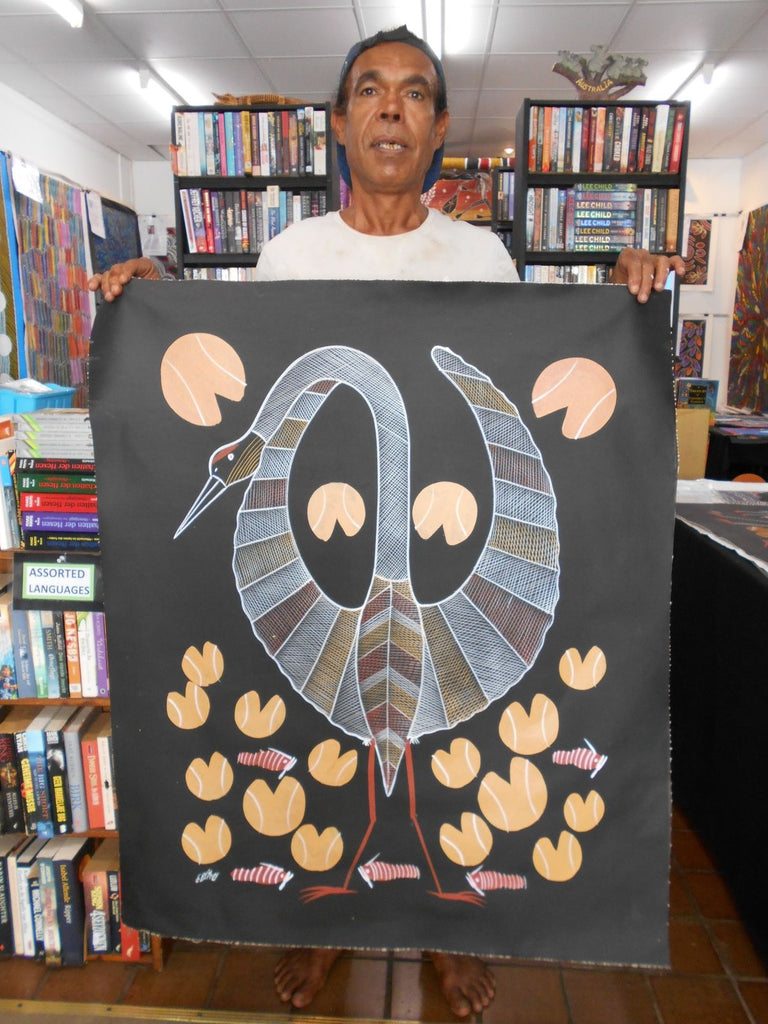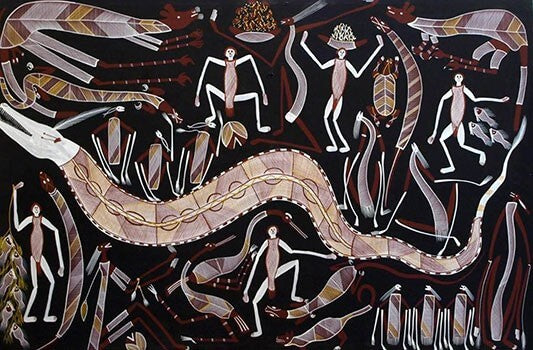News / Rarrk
Introducing Eddie Blitner
Eddie Blitner is from Naiyalrindji country on the mighty Roper River, south east of Katherine in the Northern Territory (down the Roper Highway at Yugal Mangi Nkugurr Community).
Eddie started painting at an early age where he watched and learned from his renowned clan leader grandfathers Fred, Gerry and Donald Blitner and other Elders who taught him to blend ochre, apply paint and to carve. They passed on stories of the work they were doing.
Other members of this clan (Barbil) taught him how to make flint spear heads, craft boomerangs and traditional hunting using the weapons to hunt, fish, find bush-tucker and make bush medicine to survive in the remote bush.
Eddie paints many of his family stories in his paintings of country. He incorporates totems, spirits and ancestors, bush-tucker, animals in traditional x-ray style, men's hunting and fishing and corroboree themes. Eddie takes great care in applying his craft. Often taking weeks to do final touches on his layered stories within the one canvas shot. His paints are a blend of acrylic and flicks of natural ochres and sand on the background to represent Country.
A continuing feature in Eddie's work are 'Mimi's or Mimi Spirits' - these appear in different language and clan cultures in different characters. Eddie paints the guardian Mimi spirits. These are good Mimi. Some Mimi are evil or mischievous and other types of spirit characters.
Today, as a high-profile artist, he frequently works with children and young men teaching them and passing on his skills. Eddie travels widely and is always willing to impart his traditional knowledge and artist skills to others . Not only an artist, he is an accomplished yidaki (didgeridoo) maker and is a fine traditional carver as well. He has devoted many paid and unpaid hours helping underprivileged kids to learn what his Elders passed on to him before their early passing.
Eddie's works are a favourite of mine and he also has a strong following amongst collectors and galleries.
Cross-hatching or Rarrk painting
Cross-hatching, is a style that has been used in art making for many years by many civilisations. Its most common application in art making is in drawing where the artist wishes to 'fill' or shade a part of the artwork. Hatching is generally made by close parallel lines executed in drawing materials such as ink, pencil, charcoal, crayon, paint and the like, whereas cross-hatching is what it sounds like; another hatching pattern crossing the first one.
In Australian Aboriginal Art, the fine technique of cross-hatching (or 'Rarrk') has taken on a more structured and stylised appearance, and can have significant meaning when it is used in an artwork. It is used largely by the artists of the Northern Territory, and particularly in Arnhem Land in their bark or other fine work paintings.
The usual way Aboriginal artists achieve this is to pull a few strands of long human hair, hold them together at one end, dip them deep in the paint and then use the length of paint coated hair as a brush. The hair length is carefully pulled in a straight line across the surface of the artwork. The hairs, already straight with the weight of the paint, take the least line of resistance and straighten out perfectly, producing a fine, straight line. The process is repeated at regular intervals and then when this is dry, the same is done in the other direction. Aboriginal artists believe that these overlaid patterns of colour and line contain the power associated with that particular painting or story subject.
To view artists' work that we have in this style (click on the links below)
Eddie Blitner, Christine Burarrwanga, Reggie Sultan Apengarte


